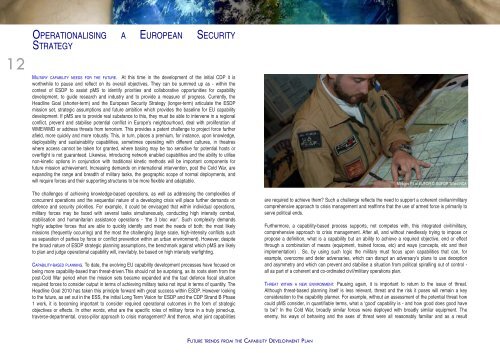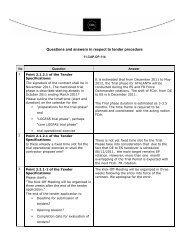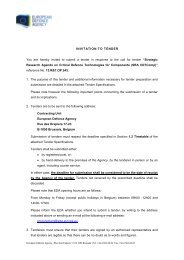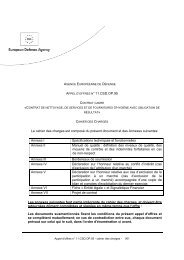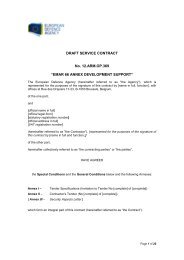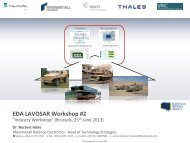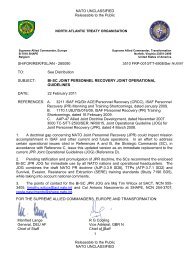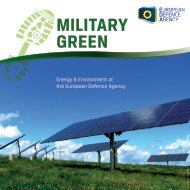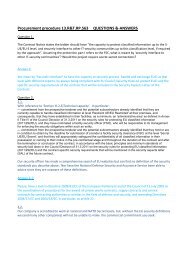capability development plan - European Defence Agency - Europa
capability development plan - European Defence Agency - Europa
capability development plan - European Defence Agency - Europa
You also want an ePaper? Increase the reach of your titles
YUMPU automatically turns print PDFs into web optimized ePapers that Google loves.
12<br />
OPERATIONALISING A EUROPEAN SECURITY<br />
STRATEGY<br />
MILITARY CAPABILITY NEEDS FOR THE FUTURE. At this time in the <strong>development</strong> of the initial CDP it is<br />
worthwhile to pause and reflect on its overall objectives. They can be summed up as - within the<br />
context of ESDP to assist pMS to identify priorities and collaborative opportunities for <strong>capability</strong><br />
<strong>development</strong>, to guide research and industry and to provide a measure of progress. Currently, the<br />
Headline Goal (shorter-term) and the <strong>European</strong> Security Strategy (longer-term) articulate the ESDP<br />
mission set, strategic assumptions and future ambition which provides the baseline for EU <strong>capability</strong><br />
<strong>development</strong>. If pMS are to provide real substance to this, they must be able to intervene in a regional<br />
conflict, prevent and stabilise potential conflict in Europe’s neighbourhood, deal with proliferation of<br />
WME/WMD or address threats from terrorism. This provides a patent challenge to project force further<br />
afield, more quickly and more robustly. This, in turn, places a premium, for instance, upon knowledge,<br />
deployability and sustainability capabilities, sometimes operating with different cultures, in theatres<br />
where access cannot be taken for granted, where basing may be too sensitive for potential hosts or<br />
overflight is not guaranteed. Likewise, introducing network enabled capabilities and the ability to utilise<br />
non-kinetic options in conjunction with traditional kinetic methods will be important components for<br />
future mission achievement. Increasing demands on international intervention, post the Cold War, are<br />
expanding the range and breadth of military tasks, the geographic scope of normal deployments, and<br />
will require forces and their supporting structures to be more flexible and adaptable.<br />
The challenges of achieving knowledge-based operations, as well as addressing the complexities of<br />
concurrent operations and the sequential nature of a developing crisis will place further demands on<br />
defence and security priorities. For example, it could be envisaged that within individual operations,<br />
military forces may be faced with several tasks simultaneously, conducting high intensity combat,<br />
stabilisation and humanitarian assistance operations - ‘the 3 bloc war’. Such complexity demands<br />
highly adaptive forces that are able to quickly identify and meet the needs of both; the most likely<br />
missions (frequently occurring) and the most the challenging (large scale, high-intensity conflicts such<br />
as separation of parties by force or conflict prevention within an urban environment). However, despite<br />
the broad nature of ESDP strategic <strong>plan</strong>ning assumptions, the benchmark against which pMS are likely<br />
to <strong>plan</strong> and judge operational <strong>capability</strong> will, inevitably, be based on high intensity warfighting.<br />
CAPABILITY-BASED PLANNING. To date, the evolving EU <strong>capability</strong> <strong>development</strong> processes have focused on<br />
being more <strong>capability</strong>-based than threat-driven.This should not be surprising, as its roots stem from the<br />
post-Cold War period when the mission sets became expanded and the taut defence fiscal situation<br />
required forces to consider output in terms of achieving military tasks not input in terms of quantity. The<br />
Headline Goal 2010 has taken this principle forward with great success within ESDP. However looking<br />
to the future, as set out in the ESS, the initial Long Term Vision for ESDP and the CDP Strand B Phase<br />
1 work, it is becoming important to consider required operational outcomes in the form of strategic<br />
objectives or effects. In other words, what are the specific roles of military force in a truly joined-up,<br />
traverse-departmental, cross-pillar approach to crisis management And thence, what joint capabilities<br />
Mirages F1 at EUFOR © EUFOR Tchad RCA<br />
are required to achieve them Such a challenge reflects the need to support a coherent civilian/military<br />
comprehensive approach to crisis management and reaffirms that the use of armed force is primarily to<br />
serve political ends.<br />
Furthermore, a <strong>capability</strong>-based process supports, not competes with, this integrated civil/military,<br />
comprehensive approach to crisis management. After all, and without needlessly trying to impose or<br />
propose a definition, what is a <strong>capability</strong> but an ability to achieve a required objective, end or effect<br />
through a combination of means (equipment, trained forces, etc) and ways (concepts, etc and their<br />
implementation) . So, by using such logic the military must focus upon capabilities that can, for<br />
example, overcome and deter adversaries, which can disrupt an adversary’s <strong>plan</strong>s to use deception<br />
and asymmetry and which can prevent and stabilise a situation from political spiralling out of control -<br />
all as part of a coherent and co-ordinated civil/military operations <strong>plan</strong>.<br />
THREAT WITHIN A NEW ENVIRONMENT. Pausing again, it is important to return to the issue of threat.<br />
Although threat-based <strong>plan</strong>ning itself is less relevant, threat and the risk it poses will remain a key<br />
consideration to the <strong>capability</strong> <strong>plan</strong>ner. For example, without an assessment of the potential threat how<br />
could pMS consider, in quantifiable terms, what a ‘good’ <strong>capability</strong> is - and how good does good have<br />
to be In the Cold War, broadly similar forces were deployed with broadly similar equipment. The<br />
enemy, his ways of behaving and the axes of threat were all reasonably familiar and as a result<br />
FUTURE TRENDS FROM THE CAPABILITY DEVELOPMENT PLAN


